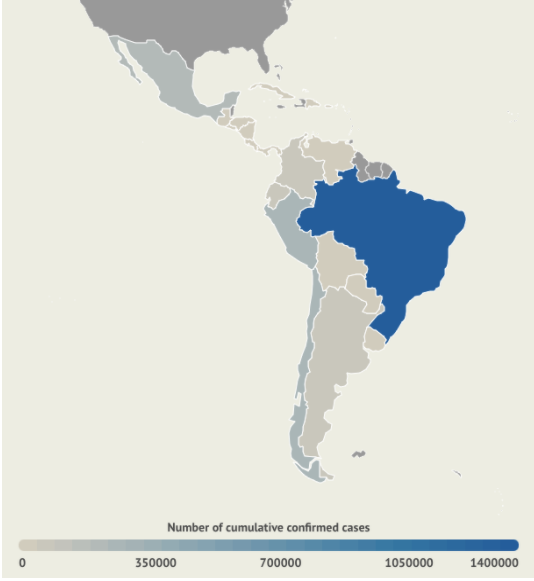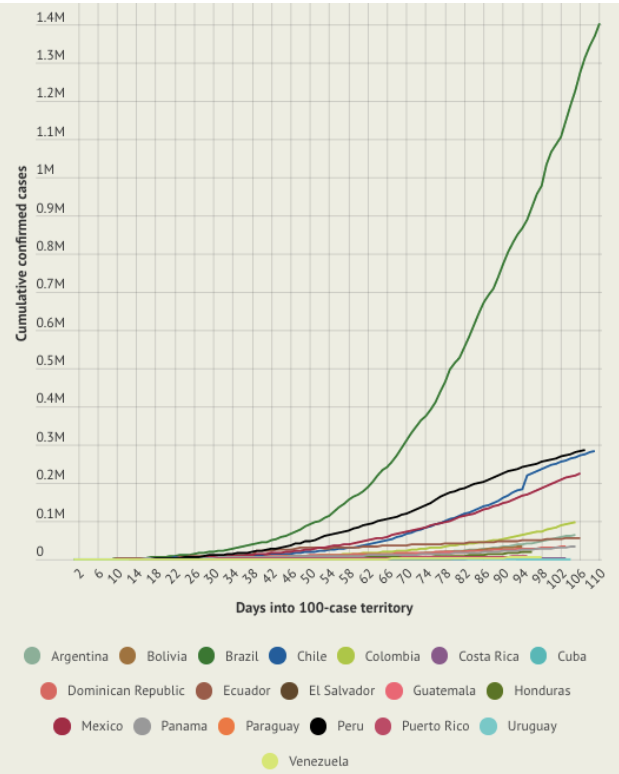COVID-19 Pandemic - South America

BY: ARUSH BHARDWAJ
The following article is a brief description of the current predicament faced in the South American region of the world with regards to the current COVID-19 Pandemic. All of the sources utilized to formulate this brief analysis have been referenced towards the end of the page.
The initial occurrences of the virus in South America were first documented on February 26, 2020, in the city of São Paulo, Brazil. Since then, a great variety of contingencies have been implemented in the Latin America region in order to contain the spread of COVID-19. Moreover, the rapid proliferation of the virus has now become a potential threat in the form of economic decline within the South American nations impacted by the virus, as well. As a matter of fact, the Latin American nations’ GDP is projected to display a cumulative contraction of approximately 7.2 percent due to this pandemic.
In June of 2020, the cases of this novel coronavirus in Brazil proliferated prodigiously, placing the nation at the top of global charts in terms of live cases. Since then, the spread of the virus has increased exponentially as the president of the nation, President Jair Bolsonaro, maintains his stance of not acknowledging the reality and severity of the pandemic. Brazil has allotted guidelines to its citizenry such as wearing masks in public settings, practicing sanitary habits akin to washing hands regularly, remaining within their homes as much as possible, etc. in order to ultimately reduce the spread in the nation, however, due to the lack of an adequate response from the country’s leadership the citizens remain uncertain of how they must proceed in the precarious situation that they contemporarily face. Similarly, Mexico faces a predicament that resembles that of Brazil. Mexican leadership is currently presenting obdurate sentiments regarding the necessity for the government’s swift intervention in the pandemic. As such, the nation faces a continual increase in COVID-19 cases.
In more recent times, we are seeing an exponential proliferation of cases in nations such as Peru and Chile. As of July 27, Peru and Chile both displayed death rates that ranged from 50-60 per every 100,000 people. This sudden increase of cases in nations such as Peru can most likely be attributed, in large part, to their highly congested urban areas. Urban areas such as the city of Lima, Peru harbor subdivisions, or districts, that have rather poor sanitation and residential standards in comparison to the main, affluent portions of the city itself. Such poor districts are often designated as slums, and it is these impoverished districts that are being ravaged by the COVID pandemic, along with a wide array of additional infectious diseases. Testing rates are at their highest in Chile, at approximately 82 tests per 1,000 people. The prevalence of this pandemic has taking taken quite a toll on such nations, forcing them to enforce lockdown measures.
As nations hastily began precluding and shutting down all active businesses as well as governmental institutions, cases of COVID-19 decreased for a brief time period. Nevertheless, in congruence with the rest of the world, an influx in COVID-19 cases has recently occurred in Latin America due to premature reopening attempts. In fact, in recent news, we have witnessed various world leaders get affected by this ailment due to their negligence concerning the execution of proper precautionary measures. For instance, the president of Brazil tested positive for COVID-19 after months of scrutinizing and rejecting precautionary practices such as wearing protective masks in public settings.
Image 1 Source: Americas Society Council of the Americas, “The Coronavirus in Latin America”
Image 2 Source: Americas Society Council of the Americas, “The Coronavirus in Latin America”


References
- Health, U. N. N. (2020, June 1). Central and South America now ‘intense zones’ for COVID-19 transmission | | UN News. United Nations. https://news.un.org/en/story/2020/06/1065252.
- Horton, J. (2020, July 31). Coronavirus: What are the numbers out of Latin America? BBC News. https://www.bbc.com/news/world-latin-america-52711458.
- Lisa Schnirring | News Editor | CIDRAP News | Jun 01, 2020. (2020, June 1). COVID-19 outbreaks surge in Central, South America.https://www.cidrap.umn.edu/news-perspective/2020/06/covid-19-outbreaks-surge-centra-south-america.
- Luisa Horwitz, P. N., July 07, 2020, & July 01, 2020. (2020, July 1). The Coronavirus in Latin America. https://www.as-coa.org/articles/where-coronavirus-latin-america.
